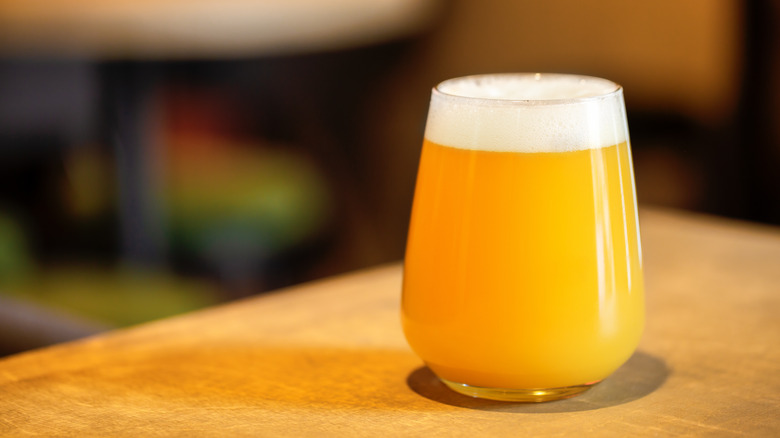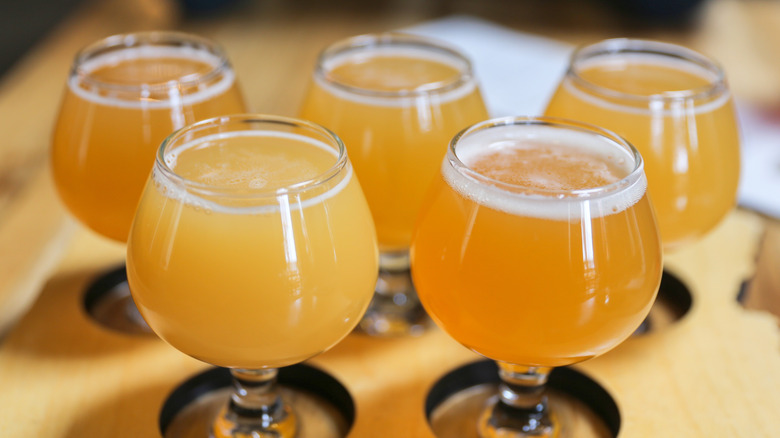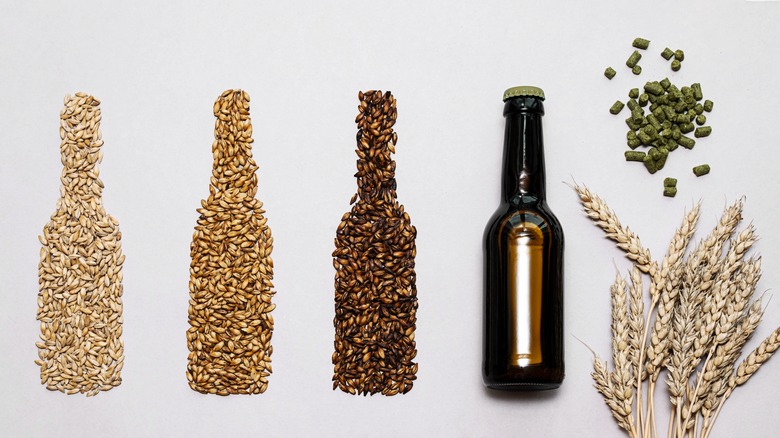What Makes IPA Beers Hazy?
Beer is one of the oldest and most popular alcoholic beverages in the world, but many aspects of its production remain a mystery to average consumers. With just four ingredients — water, grain, hops, and yeast — brewers can concoct over 100 distinct styles and sub-styles of beer, with some being well-known classics and others being newer and more mysterious. India Pale Ales (IPAs) have grown increasingly popular since the early 2000s, but casual drinkers might still have questions about these new-school brews. For instance, why do some IPAs have a hazy, opaque appearance?
Hazy IPAs are a subset of the larger IPA category. Their signature cloudiness, called turbidity, comes from insoluble proteins and residual polyphenols in the drink. The amount of these particles is determined by the grains and hopping methods used to make the beer. Hazy IPAs also use a particular type of yeast that promotes particle suspension throughout the liquid, instead of clumping together and sinking to the bottom of the barrel as sediment.
Funnily enough, beer brewers have historically avoided cloudiness at all costs. A cloudy look used to indicate that beer is too old or has been exposed to bacteria, but today, plenty of brewers and consumers appreciate hazy IPAs. The haziness actually gives these beers a smoother mouthfeel, with juicy, fruit-forward flavor profiles and less bitterness than you might find in traditional West Coast IPAs. A hazy brew is a lighter, more approachable option perfect for quenching thirst on a hot summer day.
The science behind an IPA's haze
To make a hazy IPA, also called a New England IPA or NEIPA, the first step is to prepare the grain mash. Grains that are higher in protein, like flaked oats, wheat, and rye, are milled and cooked in hot water until their starches convert to sugars, which will fuel the fermentation process later on. These grains add significant amounts of insoluble proteins to the wort, which is the sweet liquid that is drained off of the cooked grain mash. The wort is then boiled until it reaches its target gravity, or the ideal density it needs so that the final beer contains the correct amount of alcohol.
While a traditional IPA incorporates hops during the wort-boiling step, in a hazy IPA, hops are often added during whirlpooling, a final mixing step that separates solid debris from the wort. The hops might also be added even later in the fermentation stage, often using dry hopping. With this method, hops are steeped directly into the liquid for a more intense hoppy aroma and flavor.
Since the hops in a hazy IPA haven't been boiled, the beer has more polyphenols than usual, and these bind with the plentiful protein molecules to create protein-polyphenol polymers (say that five times fast). A non-flocculation yeast strain is added once the wort cools, which both aids in fermentation and prevents particles from clumping. Successful particle suspension produces the beer's hazy appearance.
The hazy IPA's roots
Hazy IPAs weren't invented just to create a novel beer with a unique, funky appearance — they were born when began brewers reexamining what hops can actually do for beer. In contrast to the way hops are used in West Coast-style IPAs, which offer biting and abrasive notes, brewers on the East Coast of the U.S. sought to unlock the gentler side of hops. These newfangled beers would have a flavor profile that hadn't yet been captured in the IPA style: a softer range that balanced bitterness with funky, fruity, and bright qualities.
In the early aughts, brewers in New England began experimenting with newer hop varieties and hopping techniques. They found that when hops were added after or during fermentation, the bitterness of a conventional IPA was diminished, and more nuanced flavors came out. An unconventional cloudiness was present in the final beers, but brewers thought this was a side effect worth dealing with for the rich, aromatic experience that came with it — especially since the opaque particles also created a silky mouthfeel.
The hazy IPA style took off in the New England craft beer scene, and then the rest of the world. Thanks to its gentler hoppy notes and fruit-forward flavors, the style appeals to hop lovers and IPA skeptics alike, and is versatile enough to work in many beer cocktails. Today, you can order yourself some excellent hazy IPAs in many of the key U.S. cities in the craft beer revolution.



